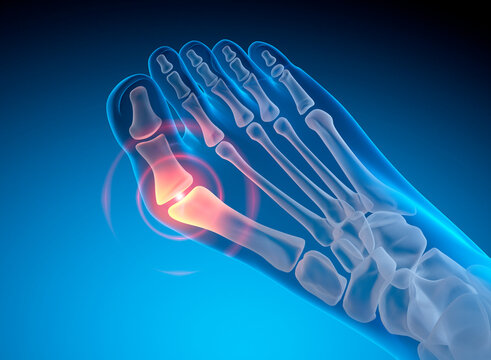Bunion (Hallux Valgus) Overview
A bunion, also known as hallux valgus, is a bony deformity that forms at the base of the big toe, causing the toe to lean towards the smaller toes. This leads to a protruding joint, often accompanied by discomfort and changes in foot shape. While the exact cause is not always known, several factors contribute to bunion development.
Causes of Bunions
- Joint Problems: Conditions such as osteoarthritis or rheumatoid arthritis can contribute to bunion formation.
- Footwear: Poorly fitting shoes, especially high heels or narrow, pointed shoes, can exacerbate or lead to bunions.
- Genetics: A family history of bunions increases the likelihood of developing them.
Symptoms of Bunions
- Pain and Stiffness: Discomfort, pain, or reduced range of motion in the big toe joint.
- Swelling: The joint may become inflamed, causing the foot to widen, which can make finding suitable footwear difficult.
- Difficulty Walking: The altered foot structure can cause discomfort and trouble with walking.
Management and Treatment
1. Footwear Changes
- Choose Supportive Shoes: Opt for well-fitting shoes with laces or adjustable straps to better accommodate your foot’s width.
- Avoid Problematic Shoes: Minimize wearing high heels, narrow, pointed, or tight-fitting shoes to reduce bunion pressure.
2. Insoles and Toe Spacers
- Insoles can provide additional support and reduce pressure on the bunion.
- Toe spacers may help to maintain proper alignment and minimize rubbing between the toes.
3. Pain Management
- Over-the-counter pain medications (e.g., ibuprofen or acetaminophen) can relieve discomfort and allow for more comfortable movement.
- Consult a healthcare professional for specific recommendations on pain management if necessary.
4. Exercises
- Foot exercises aimed at strengthening foot muscles may provide relief and help in maintaining flexibility and mobility.
- Examples include toe stretches, picking up small objects with the toes, and foot rolls.
5. Workplace Considerations
- Depending on the severity of your bunion and your job’s physical demands, you may need time off work to rest.
- Gradually returning to normal daily and work-related activities helps improve strength and endurance.
When to Seek Help
- Persistent Symptoms: If your symptoms do not improve within 12 weeks of self-care or worsen, contact a healthcare professional for further evaluation.
- Severe Pain or Difficulty Walking: A worsening condition or significant pain may require more advanced treatment options, such as injections or surgery.
Mental Wellbeing
- Managing any chronic health issue, including bunions, can impact your mental health. Be sure to care for your overall wellbeing and seek support from family, friends, or mental health professionals if needed.
With the right approach, including proper footwear, pain management, and exercises, many people find relief from bunion symptoms. Persistent or severe cases may require more specialized medical intervention, so don’t hesitate to reach out for help when needed.



 4.1 Attribution Theory and Person Perception: Why We Judge People the Way We Do (Even When We’re Totally Wrong) Let’s be honest. We’ve all
4.1 Attribution Theory and Person Perception: Why We Judge People the Way We Do (Even When We’re Totally Wrong) Let’s be honest. We’ve all



